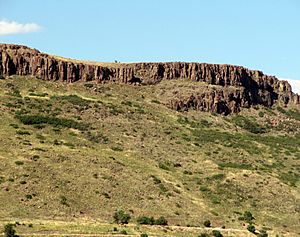North Table Mountain facts for kids
Quick facts for kids North Table Mountain |
|
|---|---|

View looking northeast from the top of Lookout Mountain.
|
|
| Highest point | |
| Elevation | 6,555 ft (1,998 m) |
| Isolation | 2.18 mi (3.51 km) |
| Geography | |
| Location | Jefferson County, Colorado, U.S. |
| Parent range | Front Range foothills |
| Topo map | USGS 7.5' topographic map Golden, Colorado |
| Geology | |
| Mountain type | Mesa |
| Climbing | |
| First ascent | 1840s by Black Kettle and tribe |
| Easiest route | Quarry road up west slope |
North Table Mountain is a flat-topped hill, called a mesa, located on the eastern side of the Front Range of the Rocky Mountains in North America. This mesa reaches a height of 6,555 feet (1,998 meters) above sea level. You can find it in North Table Mountain Park, about 3.4 miles (5.5 kilometers) northeast of downtown Golden, Colorado, in Jefferson County.
North Table Mountain is a popular spot for outdoor activities and offers amazing views near the Denver area. It is protected as a public open space by Jefferson County and the Access Fund, ensuring people can enjoy its natural beauty for years to come. Many new trails have been built to help visitors explore the area safely.
Contents
What is a Mesa?
A mesa is a special type of mountain with a very flat top and steep sides. North Table Mountain's flat top was created by ancient lava flows that cooled and hardened millions of years ago. It sits next to another similar mesa called South Table Mountain, with Clear Creek flowing between them. Both mesas were formed from the same kind of rock.
How North Table Mountain Formed
North Table Mountain is made up of layers of sedimentary rock from a time called the Paleocene epoch, which was about 62 to 64 million years ago. On top of these layers, you can see three distinct lava flows. These flows are what give the mesa its flat, cliff-like appearance.
Scientists believe the lava came from a volcanic vent located about 2 miles (3.2 kilometers) northwest of the mountain. The rocks from these lava flows are often called basalt, but they are more specifically classified as monzonite and latite. They contain interesting minerals like augite, plagioclase, and olivine.
Special Minerals: Zeolites
Both North and South Table Mountains are famous for their unique zeolite minerals. These minerals are found inside small holes, called vesicles, within the lava rocks. Some of the zeolites found here include analcime, thomsonite, mesolite, and chabazite. You can see excellent examples of these minerals at the nearby Mines Museum of Earth Science.
Animals of the Mesa
North Table Mountain is home to many different animals. In the past, animals like mountain sheep, coyotes, mountain lions, deer, and elk lived here. Today, you can still find coyotes, mountain lions, deer, elk, and rattlesnakes. To protect certain birds, especially raptors that build nests, some areas of the mountain are closed during certain times of the year. In the late 1800s, even bees used to nest in the cliffs!
A Fire on the Mountain
On July 22, 2005, a large fire started on North Table Mountain, burning over 200 acres (81 hectares). The fire was caused by fireworks set off by two teenagers. They had lit a Roman Candle, which quickly started small fires at the base of the mountain.
The fire spread very fast because it was summer and the grass was dry. Luckily, it only burned a toolshed and some other small items. Firefighters worked hard to put out the fire, and it cost a lot of money to control and extinguish it.
Images for kids





